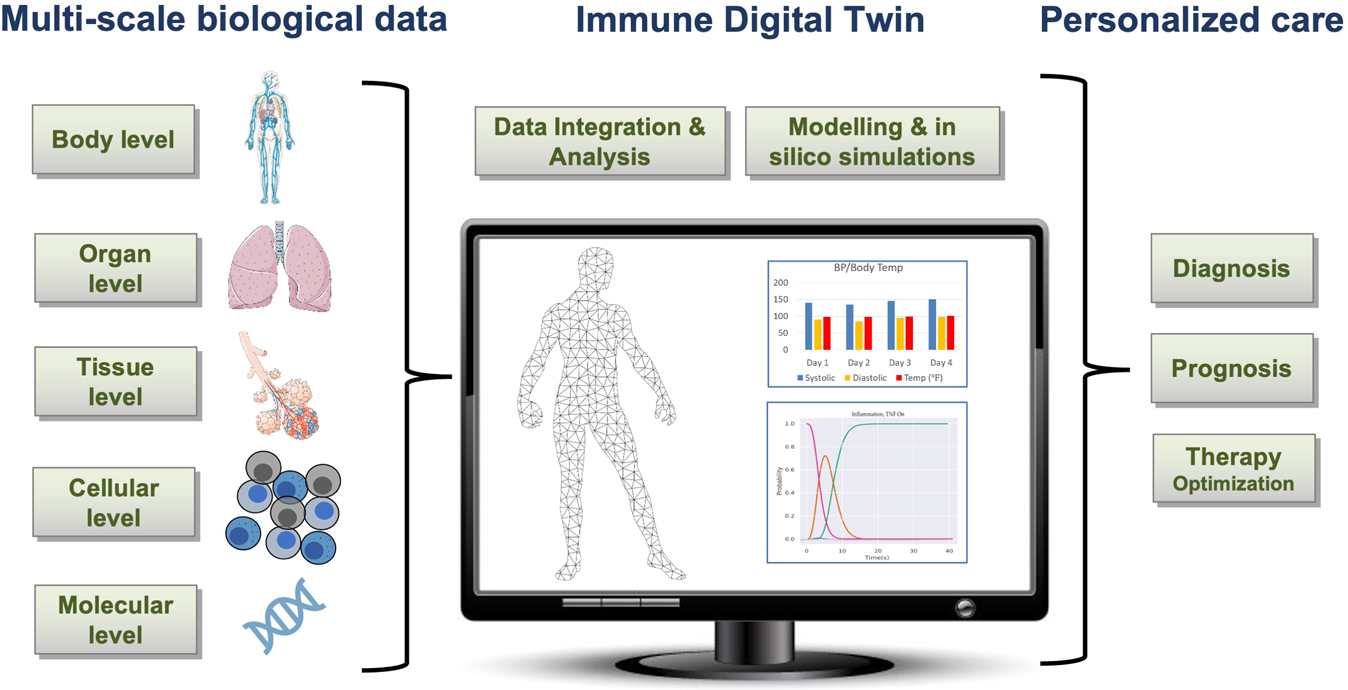Digital twins, personalized simulation models established in the industry, are now being used in healthcare and medicine, with several notable results, such as insulin pump control and cardiovascular diagnostics. Customized computational models may help with everything from medication research to therapy optimization. Additional sophisticated medical digital twins will be required to make precision medicine an actuality.
Digital twins of the immune system could be a significant influence since the immune system is involved in many illnesses and health issues, from tackling pathogens to autoimmune diseases. Nonetheless, because of the intrinsic diversity of the immune system and the complexity of evaluating many components of the immunological status of a patient in vivo, their development poses significant challenges.
About the study
In the present perspective article, the authors described a high-level sketch of a pathway for addressing the problems and developing an immune digital twin (IDT) prototype. The framework was designed as a four-stage approach that included a description of a concrete application case, construction of a model, customization, and constant improvement.

At each relevant physiological scale, known biology and relevant mechanisms are characterized through data collection that informs one or more computational models. The models at the individual scales are then integrated into a comprehensive multiscale base model. In the second step, this base model is personalized by parameterizing it with data collected from an individual patient. The resulting digital twin can then be used for clinical decision-making for this patient. (The images are public domain images from Servier Medical Art (https://smart.servier.com/smart_image/tendon-anatomy/), https://all-free-download.com/free-vector/flat-screen-computer-monitor.html, and https://pixabay.com/vectors/man-male-boy-human-people-persons-2099114/). All other images were produced by the authors). Image Credit: npj Digital Medicine (npj Digit. Med.) ISSN 2398-6352 (online)
The current IDT prototype promotes collaboration between the global non-profit scientific community, government funding organizations, and the private industry. Such an approach would require a collaborative platform and widespread consensus on the final outcome's characteristics. For example, the newly established European-led DigiTwin consortium, which encompasses clinical, industrial, and academic collaborators from 32 nations, intends to generate digital twins for every European citizen for multiple ailments and could serve as a model for several elements of an international consortium for IDTs.
The four-phase paradigm for industrial digital twin creation will be followed in the development of an IDT and was: 1) establishing a specific application and building a suitable generic template model, 2) customizing the template model to a specific patient, 3) final IDT assessment and uncertainty quantification, and 4) collecting individual patient data for continuous IDT improvement.
Findings, discussions, and conclusions
The current perspective research provided a high-level framework for advancing the IDT technique in clinical and biomedical settings. While IDTs face substantial scientific and technical difficulties, even elementary instantiations for a specific application would help concentrate continued data collecting and other enhancements, leading to increasingly better-customized simulation models with time.
The authors recommend forming a Consortium for Predictive Immunology to bring together the currently disparate transdisciplinary scientists needed to make IDTs an actuality. This integrated human infrastructure, which tightly merges modeling and clinical implementation, might help alter the characteristic of biomedical research by substantially speeding up the bench-to-bedside pathway and achieving presently unattainable medical goals. It would also open up a slew of new training models for computational and biological researchers.
The team envisions a seven-year project with two stages. The first planning process will take two years. During this period, the application, a theoretical map of the IDT, infrastructure, and the make-up of the cohort of partners will be defined. The initial step was to gather stakeholders, such as modelers, clinicians, immunologists, commercial entities, funders, and software engineers, to identify goals and techniques. The goal was to create (1) a small number of potential IDT technology applications; (2) a steering cohort that could begin and organize the next steps; and (3) a list of funding sources, starting with resources for a planning stage.
Over the next three years, the consortium will build and test a prototype model of the IDTs and the computing infrastructure that supports them. The last two years will validate the IDTs among patient studies. Further, the consortium must be supported financially as a single, cohesive project with many execution locations, having resources for modeling, software development, experimental and clinical assessments, and validation.
Notably, the investigators underline the enormous hurdles that such a project posed. Its intricacy and expense were equivalent to the Cancer Moonshot Program, financed by the United States (US) National Institutes of Health for $1.8 billion for seven years. IDT may need innovative measuring technologies, depending on the initial applications. Besides, important novel scientific discoveries and technological breakthroughs will be required to obtain IDTs that are precise and robust enough to reach industrial standards.
On the whole, the current work depicts that the IDT technique was within the human grasp. The authors mentioned that because the immune system was involved in almost all major diseases that humans confront, such as cardiac, infectious, autoimmune, and respiratory disorders, the impact of IDT might be enormous. In addition, they stated that the moment has come to get started for developing IDT techniques.